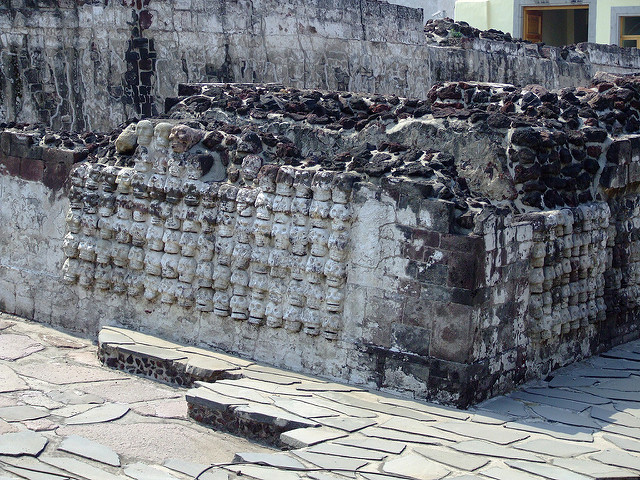
Templo Mayor de Tenochtitlán. Photo by Sam Kelly, and used under a Creative Commons license.
Now that you’ve learned about the Inca empire, religion, mythology, architecture, and engineering, you’re going to explore the same topics for the Aztec civilization.
Step 1: Locate the Google doc Dr. Madsen-Brooks created for your group. Share your contact information there, or use the document itself as a way to divvy up parts of this assignment. (Google hangouts are a good way to communicate synchronously if you want your group to meet virtually at one time.)
Step 2: With your group members, find relevant, reliable articles (secondary sources) on the Aztec empire, religion, mythology, architecture, and engineering. Keep track of your sources as you read the articles and take notes. There isn’t a specific number of sources required, but as a group, you’ll likely find and read a dozen articles or more.
Here are some tips on undertaking this kind of research:
- When you’re looking for information on the Aztecs, be sure you’re finding and using resources appropriate for a college course. There are many sites comparing the Aztecs and Incans, but many of these were designed for, or even by, K-12 students, not for adults. Don’t rely on these comparison sites, as many of them are written by younger students and are not accurate.
- Wikipedia is a good place to start. In particular, check out the resources linked in the footnotes sections of Wikipedia articles.
- Even better: use Google Scholar and the Albertsons Library article databases. The Albertsons Library reference librarians also have put together a list of resources you can use to research ancient and medieval history and world history.
Step 3: Work with your group to write, as a group, a 1,000- to 1,500-word blog post that:
- compares and contrasts Incan and Aztec sacred structures and spaces. (Include illustrations!)
- considers how the different forms of sacred structures reflect the habits, beliefs, and values of each culture.
Some tips (and requirements):
- I encourage you to write and revise the blog post in your group’s Google doc.
- When writing or editing in the Google doc, be sure you are logged into your own Google account, even if you end up getting together with other students in one physical location. Why? Dr. Madsen-Brooks will check each doc’s revision history to ensure all students contributed.
- Each member of a group will have different academic strengths. Every student should contribute to the writing and research. I encourage you to name one or two students who will edit the blog post so that the voice in which it is written remains consistent throughout the post. The remaining students should proofread the final draft before posting
- Cite your sources in endnotes. WordPress does not handle endnotes well. Instead of trying to include those tiny superscript endnote numbers at the end of every sentence, simply use a number in parentheses, like this:
- The Templo Mayor in Tenochtitlan contained shrines to the god of war, Huitzilopochtli, the god of agriculture, Tlaloc. (1)
- Then, at the bottom of the page, you would type the number 1, followed by a period and the source citation.
- Historians use the Chicago Manual of Style. Here’s a quick guide to Chicago style.
- When the group members all agree that the Google doc is ready to post, have one student log in to the course WordPress site and paste the text from the Google doc into a blog post.
- Include the names of all group members in the post.
- Include your group’s name in the title of your blog post—e.g., “Group 1: Incans vs. Aztecs” or “Incans vs. Axtecs (Group 1).” You can use any title you wish, as long as it contains your group number.
- If a group member does not contribute adequately to researching, writing, or revising the post, please send an e-mail to Dr. Madsen-Brooks expressing your concerns. Dr. Madsen-Brooks will look at the revision history to confirm the lack of participation. Similarly, if one student is not letting other students contribute sufficiently, let Dr. Madsen-Brooks know.
Group blog post due by 11 p.m. on Saturday, February 13.